Related Research Articles

The coconut tree is a member of the palm tree family (Arecaceae) and the only living species of the genus Cocos. The term "coconut" can refer to the whole coconut palm, the seed, or the fruit, which botanically is a drupe, not a nut. The name comes from the old Portuguese word coco, meaning "head" or "skull", after the three indentations on the coconut shell that resemble facial features. They are ubiquitous in coastal tropical regions and are a cultural icon of the tropics.
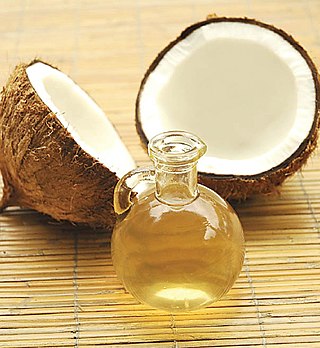
Coconut oil is an edible oil derived from the kernels, meat, and milk of the coconut palm fruit. Coconut oil is a white solid fat below around 25 °C (77 °F), and a clear thin liquid oil in warmer climates. Unrefined varieties have a distinct coconut aroma. Coconut oil is used as a food oil, and in industrial applications for cosmetics and detergent production. The oil is rich in medium-chain fatty acids.

Coconut milk is an opaque, milky-white liquid extracted from the grated pulp of mature coconuts. The opacity and rich taste of coconut milk are due to its high oil content, most of which is saturated fat. Coconut milk is a traditional food ingredient used in Southeast Asia, Oceania, South Asia, and East Africa. It is also used for cooking in the Caribbean, tropical Latin America, and West Africa, where coconuts were introduced during the colonial era.

Lupis is an Indonesian traditional sweet cake made of glutinous rice, banana leaves, coconut, and brown sugar sauce. Lupis is one of many glutinous rice desserts from Indonesia. Lupis are sometimes cylindrically shaped like Lontong. Lupis is usually eaten with thick palm sugar syrup and with shredded coconut toppings. Often eaten at breakfast or as a side dish during the evening, lupis is often sold at traditional marketplaces throughout Indonesia and is a popular food found nationwide, but especially in middle and eastern Java as well as West Sumatra. Lupis is one of the top desserts that tourists who visit Purwokerto in Java seek.

Ching bo leung is a sweet, cold soup of Chinese origin and commonly served in Cantonese cuisine, Hainanese cuisine and Guangxi cuisine. It is a popular dessert in Malaysia and Singapore. It is a type of tong sui. In Singapore it is known as 清汤. It is known as sâm bổ lượng or chè sâm bổ lượng in Vietnam.

Espasol is a cylinder-shaped Filipino rice cake. Originating from the province of Laguna, it is traditionally sold during the Christmas season. It is made from rice flour cooked in coconut milk and sweetened coconut strips and, afterwards, dusted with toasted rice flour.

The coconut crab is a species of terrestrial hermit crab, also known as the robber crab or palm thief. It is the largest terrestrial arthropod in the world, with a weight of up to 4.1 kg (9 lb). It can grow to up to 1 m in width from the tip of one leg to the tip of another. It is found on islands across the Indian Ocean, and parts of the Pacific Ocean as far east as the Gambier Islands, Pitcairn Islands and Caroline Island, similar to the distribution of the coconut palm; it has been extirpated from most areas with a significant human population, including mainland Australia and Madagascar. Coconut crabs also live on islands off the coast of Africa around Zanzibar.
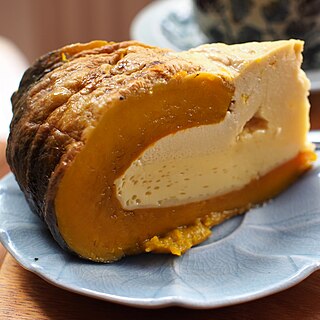
Pumpkin-coconut custard is a Southeast Asian dessert, consisting of a coconut custard steam-baked in a pumpkin.

Es teler is an Indonesian fruit cocktail. Avocado, coconut meat, grass jelly, jackfruit and other fruits are served with coconut milk, sweetened condensed milk, Pandanus amaryllifolius leaf, sugar, and a tiny amount of salt.

Opor is a type of dish cooked and braised in coconut milk from Indonesia, especially from Central Java. In Indonesia the term 'opor' refers to the method of cooking in coconut milk. Opor is a popular dish for lebaran or Eid ul-Fitr, usually eaten with ketupat and sambal goreng ati. In Yogyakarta chicken or egg opor is often eaten with gudeg and rice.

Kaeng pa is a variety of Thai curry from the forested areas of Thailand. Unlike many other Thai curries, traditional kaeng pa usually contains no coconut milk, as coconuts are not naturally found in the rainforests in the northern part of the country. This quality makes it more suitable for people on low saturated fat diets. There are, however, variants that do include coconut.
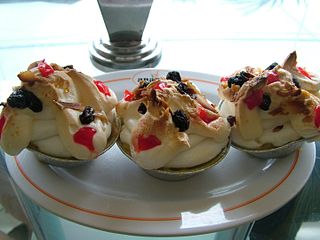
Klappertaart is a Dutch-influenced Indonesian cake originating from Manado, North Sulawesi. Klappertaart is Dutch for "coconut cake" or "coconut tart" and it's made from flour, sugar, milk, butter, and the flesh and juice of coconuts.
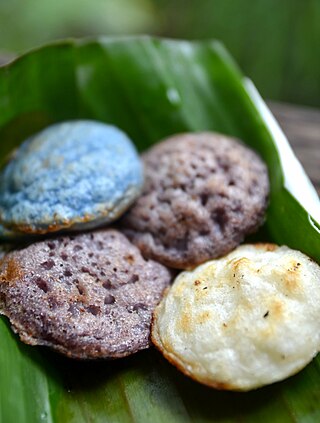
Khanom khrok or coconut-rice pancakes is a traditional Thai dessert. They are prepared by mixing rice flour, sugar, and coconut milk to form a dough. Usually, khanom khrok is composed of two batters, one salty and one sweet, both of which are cooked in a heating mantle–a hot indented frying pan. After heating, khanom khrok will be picked out of the mantle and the two half-circular doughs formed into a circular shape.

Es kelapa muda is a beverage made from chilled or iced coconut water, young coconut flesh and syrup. It is among the most popular beverages in Indonesia. Es kelapa muda is included in the world's 50 most delicious drinks according to CNN on December 9, 2011, ranking 19th.

Pichi-pichi, also spelled pitsi-pitsi, is a Filipino dessert made from steamed cassava flour balls mixed with sugar and lye. It is also commonly flavored with pandan leaves. It is served rolled in freshly grated coconut, cheese, or latik before serving.

Coconut bar is a refrigerated dim sum dessert found in Hong Kong, Taiwan, Southern China and in overseas Chinatowns. It is sweet and has a soft, gelatin-like texture but is white in color rather than translucent like gelatin. It is sometimes referred to as coconut pudding.
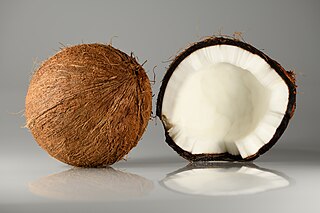
The cuisine of Nauru is the traditional cuisine of the island state on the Pacific Ocean.
Coconut burger, also known as sapal burger or niyog burger, is a Filipino veggie burger made with shredded coconut pulp (sapal), which are the by-products of traditional coconut milk extraction in Filipino cuisine. It is considered an ovo-vegetarian dish, but not vegan since it uses eggs as part of the ingredients.

Laklak is a Balinese traditional little pancake with grated coconut and melted palm sugar. This food is made of rice flour, water, coconut milk, suji leaf extract, baking powder, salt, grated coconut, and brown sugar.
Junay or junai, is a Filipino packed rice dish wrapped in banana leaves with burnt coconut meat and various spices. It originates from the Tausug people of the Sulu Archipelago. It is made by boiling rice in coconut milk until half-cooked. It is then wrapped in banana leaves with pamapa, oil, salt, and siyunog lahing. It is further steamed in water until fully cooked. The spices and burnt coconut are also sold pre-mixed and are known as pipis itum.
